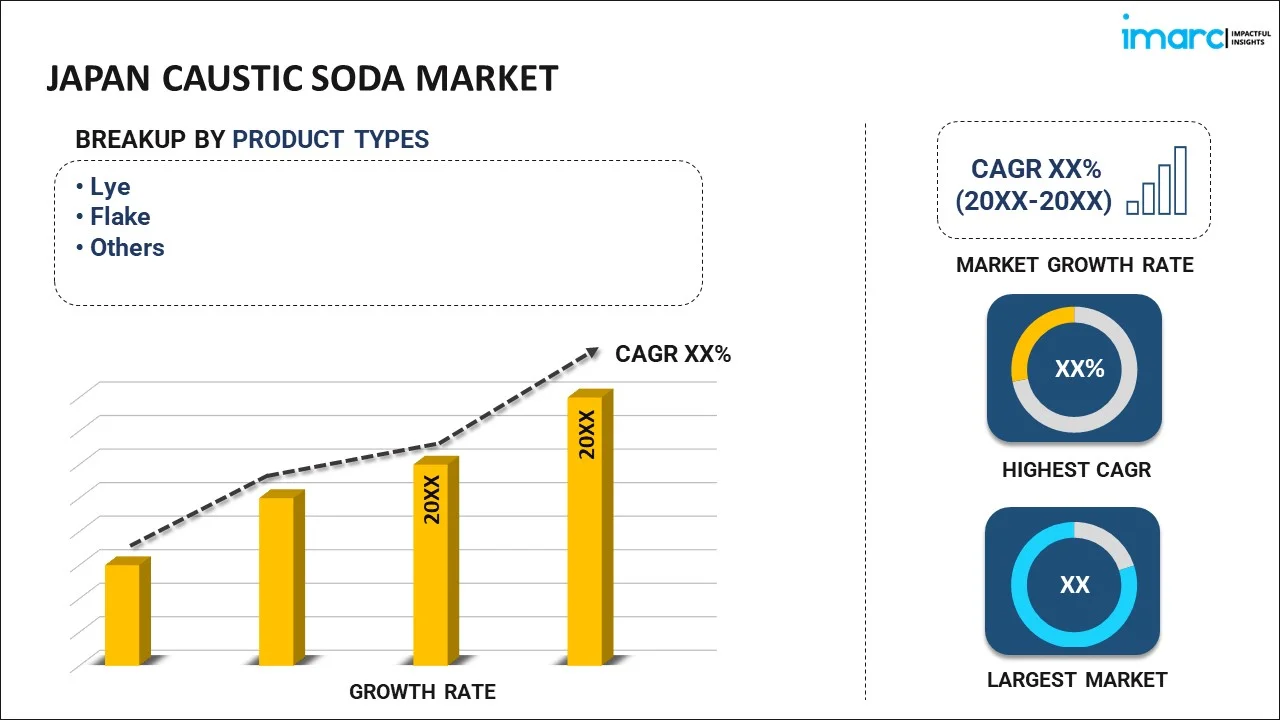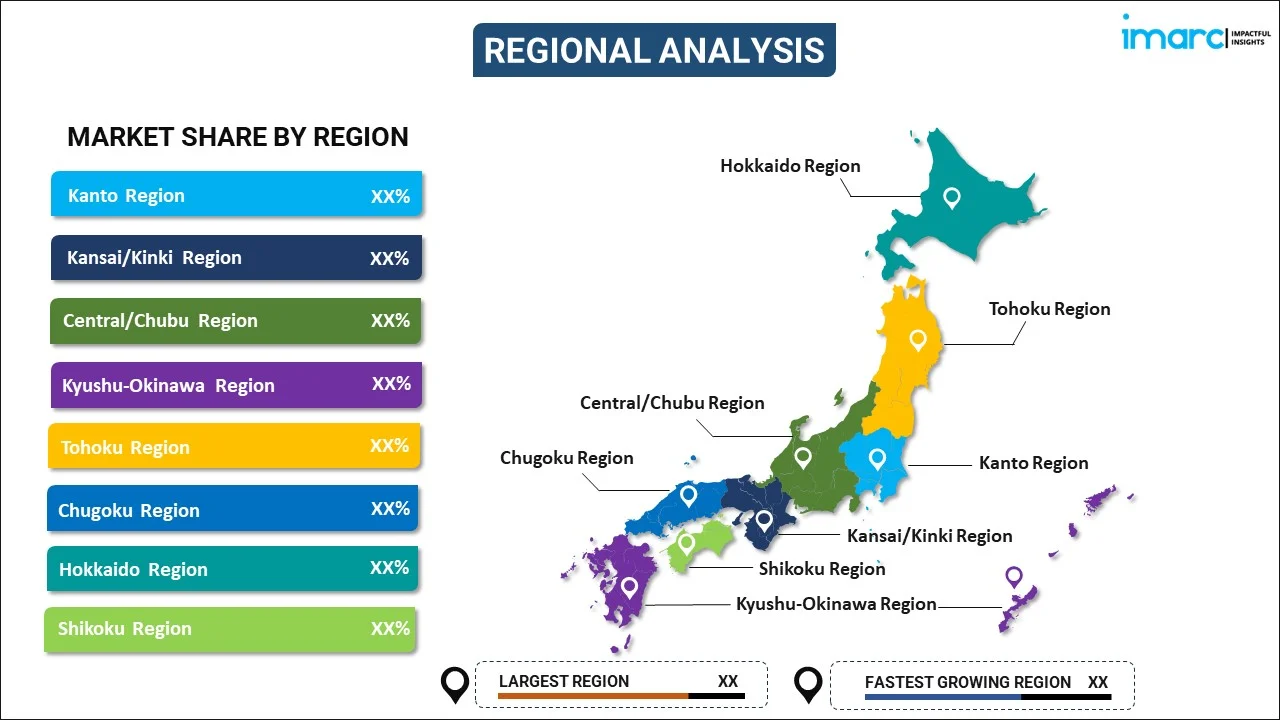
Japan Caustic Soda Market Report by Product Type (Lye, Flake, and Others), Manufacturing Process (Membrane Cell, Diaphragm Cell, and Others), Grade (Reagent Grade, Industrial Grade, Pharmaceutical Grade, and Others), Application (Alumina, Inorganic Chemicals, Organic Chemicals, Food, Pulp, and Paper, Soap and Detergents, Textiles, Water Treatment, Steel/Metallurgy-Sintering, and Others), and Region 2025-2033
Market Overview:
Japan caustic soda market size reached USD 4.4 Million in 2024. Looking forward, IMARC Group expects the market to reach USD 7.3 Million by 2033, exhibiting a growth rate (CAGR) of 5.20% during 2025-2033. The expanding petrochemical industry, which utilizes caustic soda for various processes, including refining and the production of plastics and synthetic fibers, is primarily driving the market.
|
Report Attribute
|
Key Statistics
|
|---|---|
|
Base Year
|
2024 |
|
Forecast Years
|
2025-2033
|
|
Historical Years
|
2019-2024
|
| Market Size in 2024 | USD 4.4 Million |
| Market Forecast in 2033 | USD 7.3 Million |
| Market Growth Rate (2025-2033) | 5.20% |
Caustic soda, also known as sodium hydroxide (NaOH), is a highly versatile and essential chemical compound. It is a strong alkaline substance with a variety of industrial, commercial, and household applications. Caustic soda is typically available in solid form as white pellets or flakes, but it can also be found as a concentrated liquid solution. In industry, caustic soda plays a crucial role in processes like chemical manufacturing, petroleum refining, and pulp and paper production. It is used to neutralize acids, saponify fats and oils, and control pH levels in various applications. Additionally, it's employed in water treatment to adjust water acidity and in the production of numerous chemicals, including detergents, soaps, and textiles. In households, caustic soda is commonly found in drain cleaners, where it helps break down and dissolve clogs in pipes. However, it should be handled with care due to its corrosive nature and potential hazards. Overall, caustic soda is a fundamental chemical compound with widespread utility across various industries and everyday life.
Japan Caustic Soda Market Trends:
The caustic soda market in Japan is currently witnessing robust growth, driven by a multitude of factors. Firstly, industrial applications, such as chemical manufacturing, paper production, and water treatment, have significantly contributed to the increasing demand for caustic soda. Moreover, its vital role in the alumina industry for aluminum production underscores its indispensability. Apart from this, the expansion of the textile industry has spurred the need for caustic soda as a key component in fabric treatment and dyeing processes. Additionally, the growing awareness of wastewater treatment and environmental concerns has led to increased adoption of caustic soda for effluent management, aligning with stringent regulations governing industrial waste disposal. In the realm of petroleum and petrochemicals, caustic soda plays a pivotal role in refining processes, thereby driving its demand in tandem with the expanding energy sector. The flourishing food processing industry also relies on caustic soda for various applications, including food preservation and cleaning. In conclusion, the caustic soda market in Japan continues to thrive, driven by a confluence of factors spanning diverse industries, underscoring its versatility and indispensability in various applications.
Japan Caustic Soda Market Segmentation:
IMARC Group provides an analysis of the key trends in each segment of the market, along with forecasts at the country level for 2025-2033. Our report has categorized the market based on product type, manufacturing process, grade, and application.
Product Type Insights:
 `
`
- Lye
- Flake
- Others
The report has provided a detailed breakup and analysis of the market based on the product type. This includes lye, flake, and others.
Manufacturing Process Insights:
- Membrane Cell
- Diaphragm Cell
- Others
A detailed breakup and analysis of the market based on the manufacturing process have also been provided in the report. This includes membrane cell, diaphragm cell, and others.
Grade Insights:
- Reagent Grade
- Industrial Grade
- Pharmaceutical Grade
- Others
The report has provided a detailed breakup and analysis of the market based on the grade. This includes reagent grade, industrial grade, pharmaceutical grade, and others.
Application Insights:
- Alumina
- Inorganic Chemicals
- Organic Chemicals
- Food, Pulp, and Paper
- Soap and Detergents
- Textiles
- Water Treatment
- Steel/Metallurgy-Sintering
- Others
A detailed breakup and analysis of the market based on the application have also been provided in the report. This includes alumina, inorganic chemicals, organic chemicals, food, pulp, and paper, soap and detergents, textiles, water treatment, steel/metallurgy-sintering, and others.
Regional Insights:

- Kanto Region
- Kansai/Kinki Region
- Central/ Chubu Region
- Kyushu-Okinawa Region
- Tohoku Region
- Chugoku Region
- Hokkaido Region
- Shikoku Region
The report has also provided a comprehensive analysis of all the major regional markets, which include Kanto Region, Kansai/Kinki Region, Central/ Chubu Region, Kyushu-Okinawa Region, Tohoku Region, Chugoku Region, Hokkaido Region, and Shikoku Region.
Competitive Landscape:
The market research report has also provided a comprehensive analysis of the competitive landscape. Competitive analysis such as market structure, key player positioning, top winning strategies, competitive dashboard, and company evaluation quadrant has been covered in the report. Also, detailed profiles of all major companies have been provided.
Japan Caustic Soda Market Report Coverage:
| Report Features | Details |
|---|---|
| Base Year of the Analysis | 2024 |
| Historical Period | 2019-2024 |
| Forecast Period | 2025-2033 |
| Units | Million USD |
| Scope of the Report | Exploration of Historical and Forecast Trends, Industry Catalysts and Challenges, Segment-Wise Historical and Predictive Market Assessment:
|
| Product Types Covered | Lye, Flake, Others |
| Manufacturing Processes Covered | Membrane Cell, Diaphragm Cell, Others |
| Grades Covered | Reagent Grade, Industrial Grade, Pharmaceutical Grade, Others |
| Applications Covered | Alumina, Inorganic Chemicals, Organic Chemicals, Food, Pulp, and Paper, Soap and Detergents, Textiles, Water Treatment, Steel/Metallurgy-Sintering, Others |
| Regions Covered | Kanto Region, Kansai/Kinki Region, Central/ Chubu Region, Kyushu-Okinawa Region, Tohoku Region, Chugoku Region, Hokkaido Region, Shikoku Region |
| Customization Scope | 10% Free Customization |
| Post-Sale Analyst Support | 10-12 Weeks |
| Delivery Format | PDF and Excel through Email (We can also provide the editable version of the report in PPT/Word format on special request) |
Key Questions Answered in This Report:
- How has the Japan caustic soda market performed so far and how will it perform in the coming years?
- What has been the impact of COVID-19 on the Japan caustic soda market?
- What is the breakup of the Japan caustic soda market on the basis of product type?
- What is the breakup of the Japan caustic soda market on the basis of manufacturing process?
- What is the breakup of the Japan caustic soda market on the basis of grade?
- What is the breakup of the Japan caustic soda market on the basis of application?
- What are the various stages in the value chain of the Japan caustic soda market?
- What are the key driving factors and challenges in the Japan caustic soda?
- What is the structure of the Japan caustic soda market and who are the key players?
- What is the degree of competition in the Japan caustic soda market?
Key Benefits for Stakeholders:
- IMARC’s industry report offers a comprehensive quantitative analysis of various market segments, historical and current market trends, market forecasts, and dynamics of the Japan caustic soda market from 2019-2033.
- The research report provides the latest information on the market drivers, challenges, and opportunities in the Japan caustic soda market.
- Porter's five forces analysis assist stakeholders in assessing the impact of new entrants, competitive rivalry, supplier power, buyer power, and the threat of substitution. It helps stakeholders to analyze the level of competition within the Japan caustic soda industry and its attractiveness.
- Competitive landscape allows stakeholders to understand their competitive environment and provides an insight into the current positions of key players in the market.
Need more help?
- Speak to our experienced analysts for insights on the current market scenarios.
- Include additional segments and countries to customize the report as per your requirement.
- Gain an unparalleled competitive advantage in your domain by understanding how to utilize the report and positively impacting your operations and revenue.
- For further assistance, please connect with our analysts.
 Inquire Before Buying
Inquire Before Buying
 Speak to an Analyst
Speak to an Analyst
 Request Brochure
Request Brochure
 Request Customization
Request Customization




.webp)




.webp)












